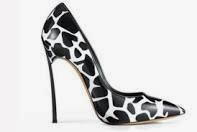Wearing a belt well is one of those litmus test of fashion : the simple task, done Right, confirms you as a man who knows his clothes. A mismatch or other errors shows that you still need to learn about dressing well. Fortunately, the basic of good belts aren't hard to learn, and most are common sense - the rest is personal taste -and belts allow plenty of room to express it.
BELT LENGTH
Dress belts should have a few inches of leather to the left of the buckle once it's fastened. Casual belts have a little more room for flexibility but an overly long tail and is always an awkward look. Store-bought dress belts are usually measured with a range of pant sizes. Pick your belts 2-3 sizes larger than your pants to get a good fit. If you wear a 34" trouser waist, a belt labelled 36"-38" will prollie be in the right neighbourhood.
BELT BUCKLES
The bigger your belt buckle the less formal it is. Dress belts have very small flat belt buckles. Larger buckles with rounded shapes are common on more casual styles. Almost all dress belts will have either a gold-coloured or silver-coloured finish. If you wear a male jewelry of any kind-cufflinks, tie tacs...the belt should be in the same colour family. Only a wedding ring is always an exception. Silver accent with silver buckle and gold with gold.
BELT COLOURS
"Leather should always match leather". That rule stays with you in dress and casual wear; brown leathershoes with brown belts. Glossy belts should be paired with highly-polished shoes; matte shoes go with matte belts. If you wearing casual shoes that aren't made of leather, you have freedom to work with cloth belts of a different colour.
Rare animal patterns can be very expensive, but should still be considered casual wear. A very high-quality ostrich -ski belt is too ostentatious for a business setting. Just keep in mind how much attention you want being drawn to your midsection.
BUYING A BELT
The quality of the leather is one common factor ; CALFSKIN is the most common material used for belts, and a good belt will have a soft, supple leather. Flex the belt to make sure it has turned brittle or started to crack. Another good test of leather is to score the back very lightly with your fingernail -if a faint line appears, the leather is still soft and fresh. Old hard leather will resist your nail. Brand name also play a factor, but means quite a bit less than other factors. Your belt is too small for most people to be able to tell at a glance whether it's designer or not. Spend money on quality instead.
BELT & JEAN LABELS
Speaking of designer goods, some high-end jeans have a famous label right between two of the belt loops. You may be temptedto have the belt off so that the label can be displayed more prominently.
Its not a great idea in general. Unbelted jeans, even expensive ones make you look like a "slob". Choose a slim belt that let's part of the label show and leave it to other people to notice your fantastic style or not.
You weren't going to impress them anyway, right?

















































